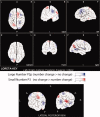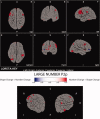Spatiotemporal dynamics of processing nonsymbolic number: an event-related potential source localization study
- PMID: 21830257
- PMCID: PMC3888832
- DOI: 10.1002/hbm.21352
Spatiotemporal dynamics of processing nonsymbolic number: an event-related potential source localization study
Abstract
Coordinated studies with adults, infants, and nonhuman animals provide evidence for two distinct systems of nonverbal number representation. The "parallel individuation" (PI) system selects and retains information about one to three individual entities and the "numerical magnitude" system establishes representations of the approximate cardinal value of a group. Recent event-related potential (ERP) work has demonstrated that these systems reliably evoke functionally and temporally distinct patterns of brain response that correspond to established behavioral signatures. However, relatively little is known about the neural generators of these ERP signatures. To address this question, we targeted known ERP signatures of these systems, by contrasting processing of small versus large nonsymbolic numbers, and used a source localization algorithm (LORETA) to identify their cortical origins. Early processing of small numbers, showing the signature effects of PI on the N1 (∼150 ms), was localized primarily to extrastriate visual regions. In contrast, qualitatively and temporally distinct processing of large numbers, showing the signatures of approximate number representation on the mid-latency P2p (∼200-250 ms), was localized primarily to right intraparietal regions. In comparison, mid-latency small number processing was localized to the right temporal-parietal junction and left-lateralized intraparietal regions. These results add spatial information to the emerging ERP literature documenting the process by which we represent number. Furthermore, these results substantiate recent claims that early attentional processes determine whether a collection of objects will be represented through PI or as an approximate numerical magnitude by providing evidence that downstream processing diverges to distinct cortical regions.
Copyright © 2011 Wiley Periodicals, Inc.
Figures






Similar articles
-
Common and segregated neural pathways for the processing of symbolic and nonsymbolic numerical magnitude: an fMRI study.Neuroimage. 2010 Jan 1;49(1):1006-17. doi: 10.1016/j.neuroimage.2009.07.071. Epub 2009 Aug 7. Neuroimage. 2010. PMID: 19666127
-
Spatial attention determines the nature of nonverbal number representation.J Cogn Neurosci. 2011 Sep;23(9):2336-51. doi: 10.1162/jocn.2010.21581. Epub 2010 Oct 20. J Cogn Neurosci. 2011. PMID: 20961170
-
Neural evidence of core foundations and conceptual change in preschool numeracy.Dev Sci. 2024 Nov;27(6):e13556. doi: 10.1111/desc.13556. Epub 2024 Aug 6. Dev Sci. 2024. PMID: 39105368
-
The number domain- can we count on parietal cortex?Neuron. 2004 Oct 28;44(3):407-9. doi: 10.1016/j.neuron.2004.10.020. Neuron. 2004. PMID: 15504322 Review.
-
Are numbers grounded in a general magnitude processing system? A functional neuroimaging meta-analysis.Neuropsychologia. 2017 Oct;105:50-69. doi: 10.1016/j.neuropsychologia.2017.01.019. Epub 2017 Jan 22. Neuropsychologia. 2017. PMID: 28119003 Review.
Cited by
-
Visual P2p component responds to perceived numerosity.Front Hum Neurosci. 2022 Nov 1;16:1014703. doi: 10.3389/fnhum.2022.1014703. eCollection 2022. Front Hum Neurosci. 2022. PMID: 36393989 Free PMC article.
-
The influence of cardiorespiratory fitness on strategic, behavioral, and electrophysiological indices of arithmetic cognition in preadolescent children.Front Hum Neurosci. 2014 May 5;8:258. doi: 10.3389/fnhum.2014.00258. eCollection 2014. Front Hum Neurosci. 2014. PMID: 24829556 Free PMC article.
-
Multiple object individuation and subitizing in enumeration: a view from electrophysiology.Front Hum Neurosci. 2015 Apr 2;9:162. doi: 10.3389/fnhum.2015.00162. eCollection 2015. Front Hum Neurosci. 2015. PMID: 25883563 Free PMC article. Review.
-
Distinct Mechanisms in Number Comparison of Random and Regular Dots: An ERP Study.Front Behav Neurosci. 2022 Jan 12;15:791289. doi: 10.3389/fnbeh.2021.791289. eCollection 2021. Front Behav Neurosci. 2022. PMID: 35095437 Free PMC article.
-
Electrophysiological Comparison of Cumulative Area and Non-Symbolic Number Judgments.Brain Sci. 2023 Jun 20;13(6):975. doi: 10.3390/brainsci13060975. Brain Sci. 2023. PMID: 37371453 Free PMC article.
References
-
- Ansari D, Dhital B ( 2006): Age‐related changes in the activation of the intraparietal sulcus during non‐symbolic magnitude processing: An event‐related fMRI study. J Cogn Neurosci 18: 1820–1828. - PubMed
-
- Ansari D, Dhital B, Siong SC ( 2006): Parametric effects of numerical distance on the intraparietal sulcus during passive viewing of rapid numerosity changes. Brain Res 1067: 181–188. - PubMed
-
- Ansari D, Lyons IM, van Eimeren L, Xu F ( 2007): Linking visual attention and number processing in the brain: The role of the right temporal‐parietal junction in the small and large non‐symbolic number comparison. J Cogn Neurosci 19: 1845–1853. - PubMed
-
- Brannon EM, Terrace HS ( 1998): Ordering of the numerosities 1–9 by monkeys. Science 282: 746–749. - PubMed
-
- Burr DC, Turi M, Anobile G ( 2010): Subitizing but not estimation of numerosity requires attentional resources. J Vis 10: 20. - PubMed
Publication types
MeSH terms
Grants and funding
LinkOut - more resources
Full Text Sources
Research Materials
Miscellaneous

